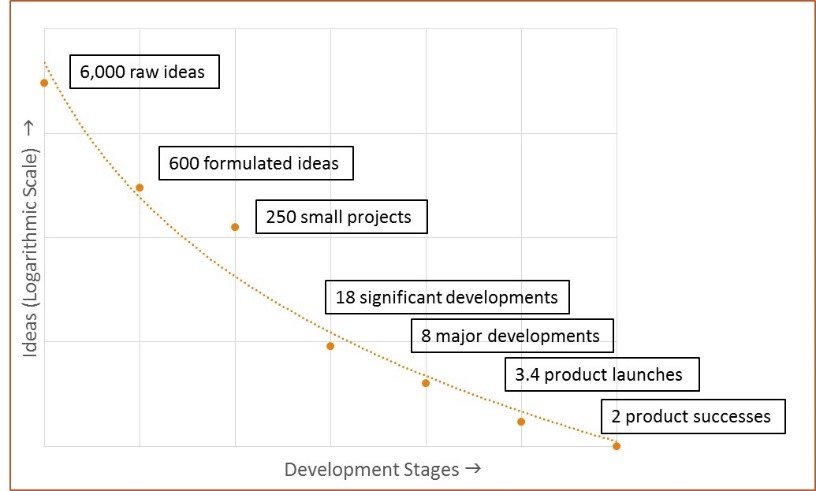“Innovation Insight” is a blog series written by SRC’s President Emeritus, Dr. Laurier Schramm, which aims to shed light on the importance of innovation in driving economic, societal and environmental growth.
Eureka! That fabulous new idea has finally crystallized in your mind. “The hard part is over with,” you might say to yourself. “It’s easy going now to create a new product, patent it, and get it to market.” Well maybe so, but more likely there’s still a lot of work remaining to be done. In 1903, Thomas Edison said, “Genius is one percent inspiration, ninety-nine percent perspiration.” But it’s worse than that. One bright, new idea in isolation has a low probability of being successfully commercialized. When questioned about his apparent lack of results in attempting to develop a practical nickel-iron battery in 1910, Edison said, “Results! Why, man, I have gotten a lot of results! I know several thousand things that won’t work.”
It’s fun quoting Edison, but it turns out that, on average, a huge amount of work and several thousand failures almost always mark the landscape between a bright new idea and a commercial success. Let’s take a look at the prior history of the average successful new product.
Product Success by Development Stage

Regardless of the industrial sector, only about 60 per cent of new product launches succeed. At earlier stages of the development process, the success rates are even lower. Only 25 per cent of products from the major development stage succeed. Only 11 per cent of products from the early stages of development succeed, even after detailed analysis. Only 0.8 per cent (1 in 125) of products from the small project stage succeed, even after a patent is granted. Only 0.3 per cent (1 in 300) of products from the developed idea stage succeed, even after a patent disclosure is made. Only 0.03 per cent (1 in 3,000) of products from the original/raw idea stage succeed. This means that to get two new products, processes, or services added to our organization’s lines of business, on average, we’ll need 6,000 new ideas, and we’ll need them soon because the development and filtering processes take a lot of time.
Improving the Success Rate
Why does all this matter? It can take a lot of time, effort, and money to get from the new idea stage all the way to a commercially successful product or service. Anything we can do to shorten the cycle time and/or reduce development costs can payback substantially by enabling more time and effort to be focused on more ideas, and anything we can do to improve the probabilities of success can payback in a huge way. Amazingly, despite over 50 years of industrial evolution since the introduction of staged-gate processes, these success rates remain substantially unchanged.
So how could the success rate be improved? Technological innovations don’t arise out of pure luck, but neither do they come from a formula or template. Similarly, managing the hand-offs from research and development to organizational units that will carry a new development into commercialization and launch needs to be more than just another routine process. Researchers pondering the success rate question have turned from looking for process factors to human factors. It turns out that, to paraphrase an old saying, “It’s all about the people …”
Tapping into Creative Minds
The research shows that engaging people with highly developed creative abilities (sometimes called “Rainmakers” or “Wizards”) throughout the new product, process, and service development process (not just at the new idea and invention stages), can increase the success rates by as much as a factor of nine. Such people tend to be good at problem identification and problem solving, and frequently serve as catalysts within teams. Some caution is in order here as highly creative spirits, by their very nature, can also be somewhat disruptive in team environments, and aren’t necessarily best-suited to other important tasks, like management and program execution. The point is that by adding some people with highly developed creative abilities to a team, one can maintain disciplined staged-gate processes while achieving a large positive impact when it comes to developing technological innovations.
Calling all creative spirits! We need 6,000 new ideas ... and then the real work can begin!
What ideas do you have for new innovation-enabling products, processes, or services?
